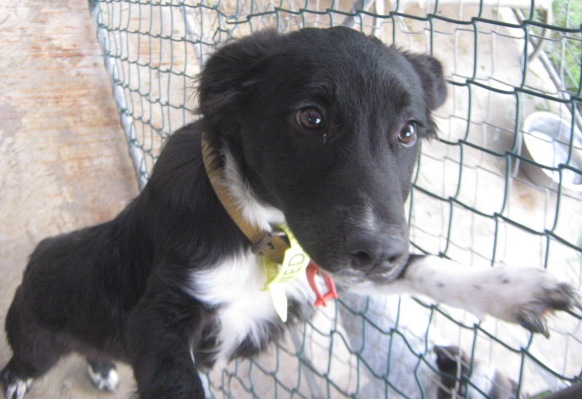by Leslie Smith, editor
March, 2011
On Thursday, a man brought a Heeler mix he called Jack to the front counter. The sight horrified those present, and the stench permeated the entire shelter grounds. Jack’s right front leg had been mutilated, and the injury was clearly not new. According to the man, the dog had been hit by a car about six weeks ago, and he was now worried maggots would begin eating away at the infected limb.
From the socket hung what looked like a partially-eaten chicken drumstick. In places, no skin, no cartilage, no tendons. Just completely exposed bone with a knob at the bottom where his paw turned under and a round, deadened area at the top connecting the leg to what was left of his shoulder. (Photo here. Warning: extremely graphic.)
This is not a wealthy community, and the actual shelter building reflects the area’s depressed economic conditions: cement floor, blocky brick walls, makeshift signs, and ramshackle shelving. What it lacks in beauty and warmth is made up for by an utterly devoted staff.
When Jack arrived, there was no question they’d do everything they could for him, despite knowing his medical care would cost thousands of dollars. The dog would not be failed by humans again.
This, from a “kill” shelter.
Every statistic is a story
When it comes to declaring mission accomplished, No Kill success boils down to a numbers game: We measure our progress in quantifiable steps forward (and backward) until we get to a nationwide live-release rate of 90% or higher. That is, 90% of all treatable animals who enter a shelter, leave the shelter alive.
But this is not a numbers issue. Every statistic represents a real animal, real suffering, real death. Imagine if you hadn’t gone to the shelter that day and your own dog was now the one now being led to the euthanasia room instead of lying at your feet as you read this. Every animal who receives the gas chamber or the blue juice is the one you might’ve adopted. Every dog or cat is someone’s almost chosen one.
Better shelter efficiency, adoption, and certainly education are all part of the equation. Changing the shelter experience, while not immediately doable in most places, is also key. (Facilities like ARF and the Humane Society of Silicon Valley have done an amazing job of transforming the perception of “animal shelter” from depressing to inspiring. Their campuses offer an extensive menu of animal-centric activities, everything from kids’ day camps to public walking trails to pet-friendly cafes.) All of the above are important items on the grand to-do list.
But in one generation, and with relatively (I said relatively) fewer human and financial resources than it takes to install new shelter leadership or make over our municipal facilities, we can get this epidemic under control. Yes, it all comes down to spay/neuter and in the end: fewer animals for whom to find homes, great homes for all who need them.
“No Suffer”: the new No Kill?
I’d like to see the U.S. become a No Kill nation. But my even greater hope is that we become a No Suffer nation. No animal deserves to die simply because the shelter is full, but neither does he deserve a life devoid of exercise, companionship, security, and medical care.
The success of a No Suffer movement would be harder to measure, but its impact, at least as profound. We’ll have achieved it when our animal cruelty legislation is strictly imposed and enforced, when our shelters are all but empty, and when euthanasia is a reprieve from incurable affliction, not a method of population control.
No Suffer would mean we’re not classifying animals in terms of how adoptable they are, but instead, we’re devoting resources to any dog or cat who needs extra care. Ultimately, we’ll know we’ve become a No Suffer nation when we’re no longer keeping track of those animals we, as humans, have failed. When the reality is truly a humane society, where every creature is respected and treated with compassion.
Read previous installment: Adoption is not the only answer
Read all installments.









